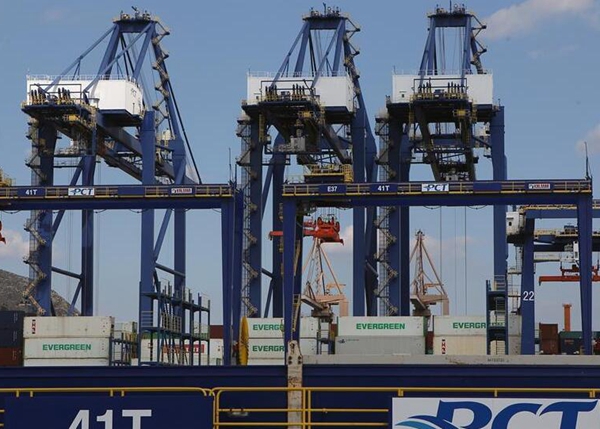Support port enterprises to go global and flesh out the layout of Maritime Silk Road ports

Photo taken on March 17, 2017 shows containers at the Piraeus Container Terminal in Greece. China's COSCO (China Ocean Shipping Group Company) acquired a majority stake in Piraeus Port Authority through the Athens Stock Exchange in April, 2016. [Marios Lolos/Xinhua]
Maritime industry is the main mode of transportation of maritime Silk Road, and ports are the important nodes for the the implementation of the Belt and Road strategy. China has become the largest port nation in the world and has established a standardized system and enjoys the capacity for overseas port construction, investment and operation with the support of capital, management and talent advantages.
Achievements accomplished by China’s port industry relating to the construction of the Belt and Road Initiative are as follows. 1. Overseas investment has made initial progress in port operation. China’s port investment for foreign containers is mainly conducted by COSCO Shipping Group and China Merchants Group, and the investment of bulk cargo terminals has gradually generated sound interactions among state-owned, private and local enterprises. 2. Various entities involved in the port construction in countries and regions along the Belt and Road routes relating to the Belt and Road Initiative include construction enterprises, enterprises responsible for surveying, planning and designing as well as port machine manufacturers and China Communications Construction Group takes the lion’s share of relevant construction projects.
The experience gained by China’s port industry in the construction of the Belt and Road Initiative is illustrated as follows. 1. Through the implementation of going global strategy, overseas port investment will help to improve China’s maritime network and foster China’s foreign trade development; the overseas investment made in foreign key ports and origin countries of resource and energy will be conducive for China to ensure the import of resource, energy and other materials; some of the overseas port investment projects have made development mode innovations by creating “port Plus industrial park” mode to drive production capacity cooperation. 2. The experience of going global. By improving the management and information system and getting integrated with local communities, they have won the trust of host countries and reduced the costs of overseas investment; by making port investment to propel construction enterprises and machine manufacturers to expand their overseas presence, project efficiency has been ensured and relevant parties have gained greater benefits.
Policy options on enhancing the Belt and Road port connectivity. 1. Connectivity of container ports. In west Asia, project construction will be the main part of cooperation with 6 member countries of Gulf Cooperation Council (GCC); Iran and Iraq are expected to become the destination of port investment and operation in west Asia in the near future. 2. The connectivity of specialized terminals for bulk cargo containers. During the construction of oil and gas terminals, China’s construction enterprises will embrace more market opportunities, but due to the restrictions caused by the nature of specialized bulk terminals, it would be better for them to make overseas investment together with resource enterprises.
Policy measures on promoting the relevant projects. International port industry is a highly market-based one, thus commercialized operation mode should play the main role in port operation and efforts should be made to follow the principle of taking enterprises as the mainstay based on market-oriented performance for sustainable development. We need to take joint efforts to encourage port industry to participate in the construction of the 21st-Century Maritime Silk Road projects. Relevant policy measures need to be bolstered by the following factors including sound diplomatic relationship, personal and property protection, investment facilitation, a fair dispute solution mechanism, management and planning technical support, specialized financing services, the sharing of related experience and means for defusing risks.
- China, Maldives upgrade ties as presidents hold talks
- Roundup: Decade-old BRI gives extra boost to Sino-Cambodian ties: experts
- Intangible cultural heritage exhibition on Maritime Silk Road held in SE China's Quanzhou
- Maritime Silk Road art festival opens in Quanzhou
- China shares opportunities with world via Maritime Silk Road

